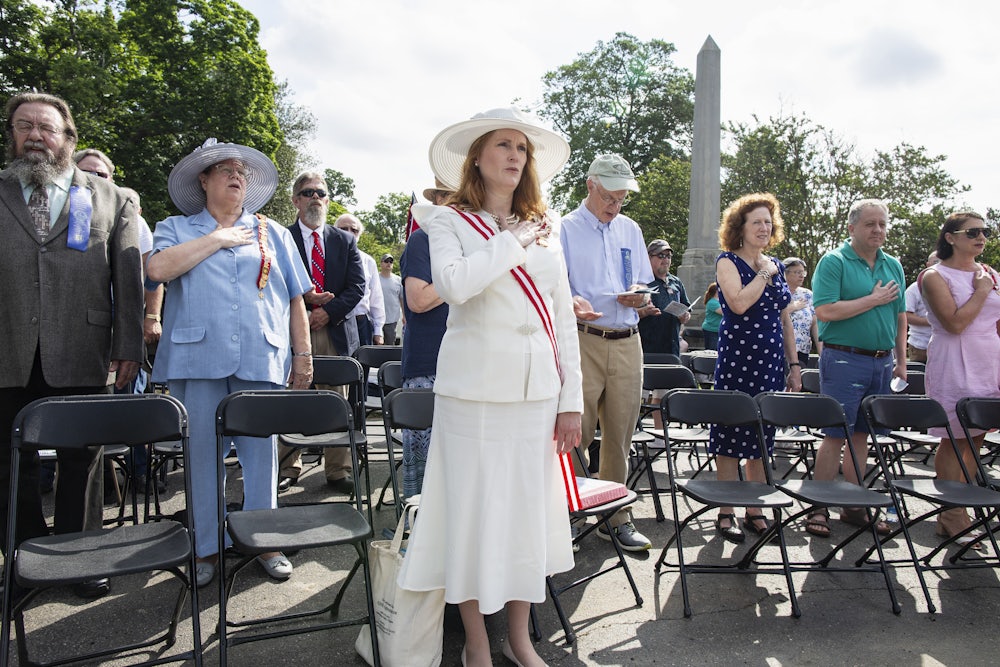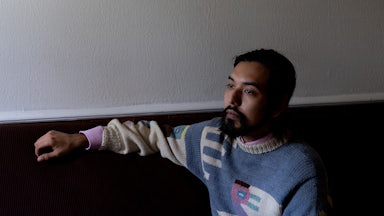The first thing I noticed about the monument to Southern women is that its Confederate flag flew upside down. One of the flagpole’s ropes had snapped so that the Stars and Bars fluttered in the breeze as the Bars and Stars. I had driven seven hours from Manhattan to see the memorial, a squat marble building that looms over a tree-lined boulevard in Richmond, Virginia. The rebel nation’s former capital has contended with its legacy by removing all Confederate statues from city property. But I know this monument was recently polished. From the sidewalk, I could see the cotton bolls and ribbons etched into the bronze double doors. I could see engraved across the marble front: United Daughters of the Confederacy.
I had called the headquarters, and would continue to call, asking for a tour, something the women once offered to the public upon request. Now, a Keep Out sign positioned near a UDC placard clarifies what passersby should know about the organization. “So many people in Richmond walk by and see this big marble building,” one local would tell me, adding that it’s beautiful. “But they’re not allowed to see what’s actually inside.”
The women were friendly on the phone but stuck to a demurring script: They needed to ask someone who needed to ask someone else—they would call me back. They never called me back, confirming what their signs stated clearly: The UDC wanted me to Keep Out.
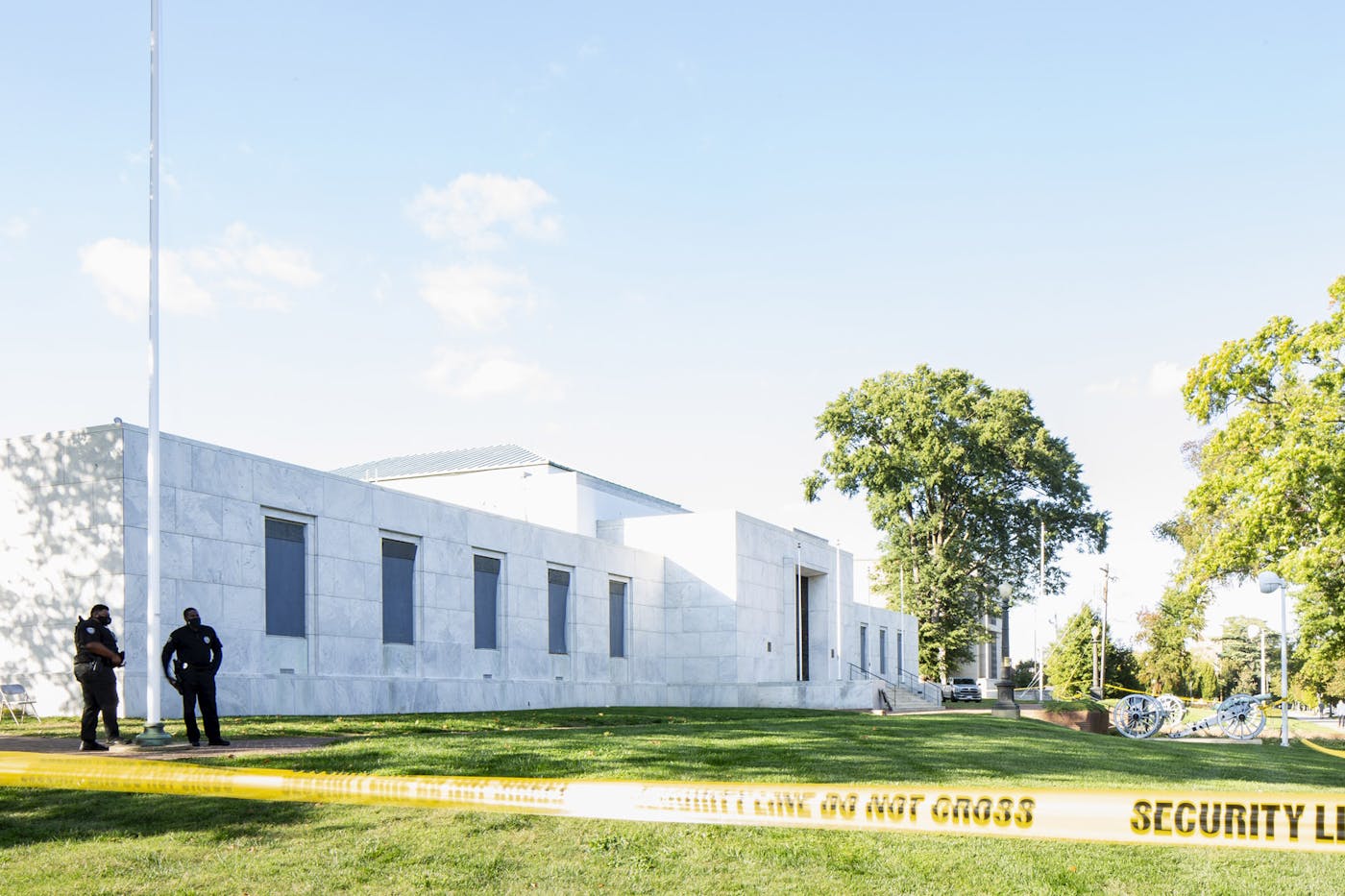
I traveled to Richmond in August with no promise that I would tour the building, but that was OK. After all, memorials are meant to point us past marble and to the living world. I didn’t need to enter the building to know the country’s most infamous Confederate heritage group. And I didn’t need to see their flag to know that the organization itself is hanging by its last thread.
After Charlottesville’s deadly Unite the Right rally in 2017, the country turned its scrutinizing eye to Confederate statues, landing its gaze on those who built them: the UDC. But rather than reckon with their past work, the Daughters, as The Washington Post wrote, were “stunningly silent” when contacted for comment. Nine days after Charlottesville, a statement denouncing white supremacy and defending Confederates appeared on the UDC’s website. Rare exceptions notwithstanding, the statement functions as their final word.
Though its statues punctuated the landscape of my childhood in Alabama, I didn’t learn about the UDC until 2021, when I began researching scholarships for journalism school. I discovered that as the progeny of Confederates, I’m the type the Daughters like to support. The more I read about the UDC, the more I realized how much talking the organization did a century ago, talking that shaped Southern culture as I know it. And despite the current reticence, it appears the UDC still wants to influence people like me.
I wasn’t surprised to encounter the organization’s stunning silence when I reached out, introducing myself as a fellow Southerner interested in writing about the group. I was surprised to find a chapter of Confederate Daughters in New York, though. These women were delighted to find an Alabamian in the city; I was stunned to find Confederates in Manhattan. When the chapter president sent me a membership application, I iterated that I wanted to write about the organization. She replied that I should write for the UDC’s magazine.
When I considered my adulthood outside of Alabama—one spent realizing how insidiously white supremacist ideas permeate my native culture, spent deconstructing ideas constructed by entities like the UDC—I felt compelled, one white Southern woman to another, to take a closer look at the UDC. It didn’t sit right that they would go silent when the national conversation changed. And with an application in my inbox, and the prodding of my journalism professors, there seemed to be another way to get to know them.
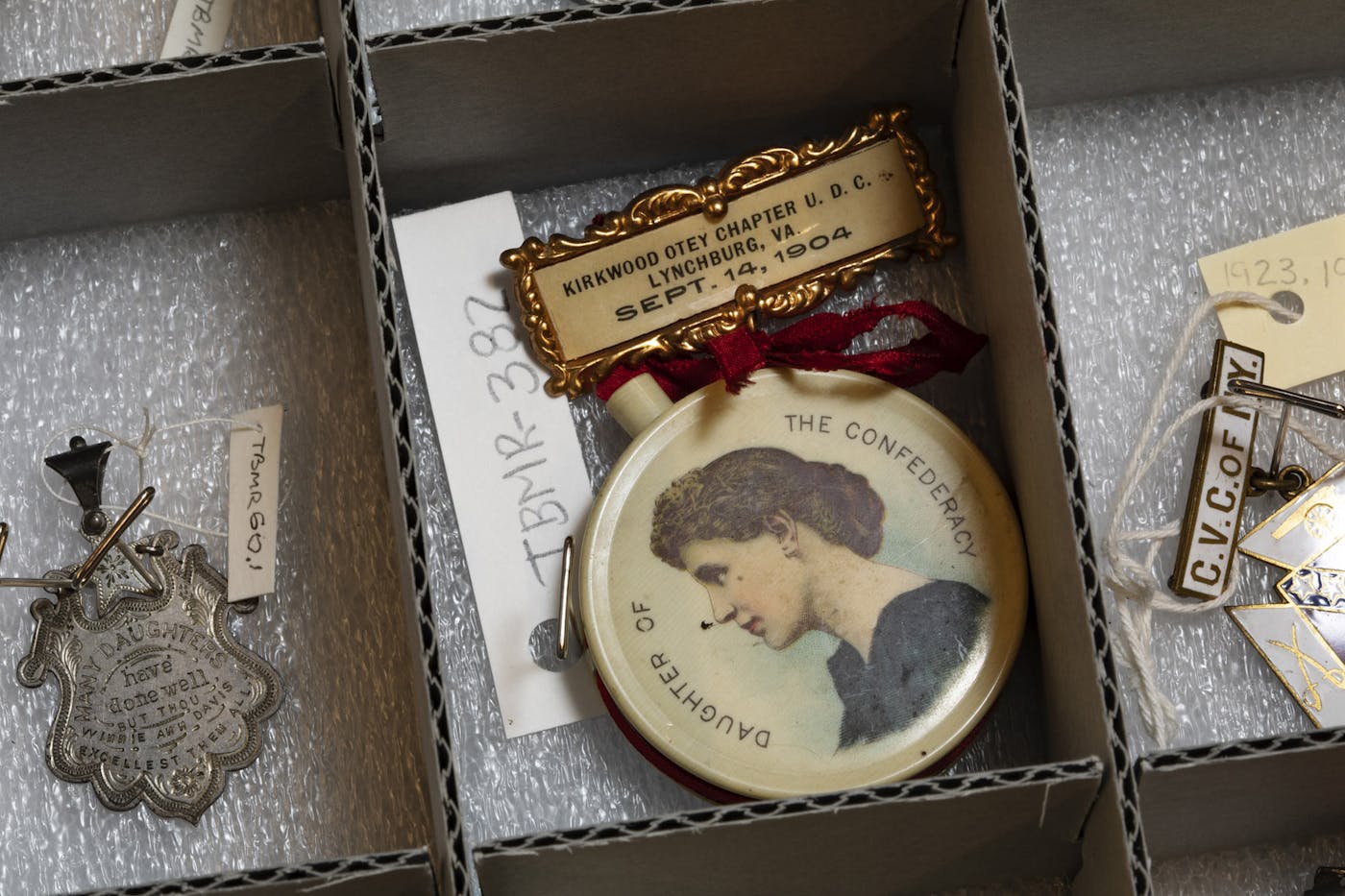
Meetings began with the Pledge of Allegiance and a salute to the Confederate flag. “Dixie” was skipped because singing in unison over Zoom was tricky. The chapter boasted 500 members a century ago, I was told, but an average of seven women now attended. They were sweet and welcoming, and their conversations regularly turned to two things: the cost of preserving their memorial building and their public image. Considering their refusal to speak with journalists, I found it ironic when a woman leaned into her square to say, “They all think we’re white supremacists”—the identity of “they” wasn’t specified—“but they don’t want to bother to find out.”
When speaking with experts for this article, I noticed an assumption that the organization no longer meets. This is not the case. I gathered with Daughters in October 2021, when the chapter convened in Manhattan for wine, cheese, and a lecture on Confederate diversity. Two weeks later, I flew to a seaside resort in Myrtle Beach for the national convention. By the end of the event, attended by 300 Daughters from across the country, the “Look away! Look away!” refrain of “Dixie” remained stuck in my head.
After the convention, I lost touch with the UDC. But when my graduate work became an opportunity to write for this magazine, I decided to properly reach out as a journalist to Margaret, a leader with the New York chapter. Margaret, who I would guess is a young septuagenarian, has been in the UDC most of her life. I decided to change her name for this article.
Over Zoom, I confirmed that I was now reporting for The New Republic. I planned to write about the UDC’s memorial building, one of Richmond’s last Confederate monuments, and whom it memorialized. Since I had spent time with the Daughters, I hoped they would break their silence with me, and I was stunned when Margaret responded enthusiastically about sitting for an interview: “I am interested in people understanding that the organization is a forward-looking organization.” Her cat crawled across her lap, and she wiggled its tail toward the screen. The meeting ended with smiles, but when she followed up, it was to let me know she’d changed her mind. She hoped, without explanation, I would understand. Other UDC leaders replied to my subsequent emails with a “respectfully decline,” or with silence.
When Margaret said the UDC is forward-looking, I told her I looked forward to learning how. I had a lot of questions, and I was disappointed the Daughters wouldn’t give me the chance to ask. Maybe they’d change their minds by the time I got to Richmond. Either way, by now, I had already heard the UDC speak.
“The time has come when the South, the true home of the Anglo-Saxon race, which has stood for truth and honesty and righteousness in the past, should come back to the faith and principles for which their forefathers stood.” This 1925 call to make Dixie Confederate again came from Mildred Lewis Rutherford, a prominent historian general of the UDC. A decade prior, a Daughter published The Ku Klux Klan, or Invisible Empire, a children’s textbook that exonerated the Klan. The “heroes” protected white women from “ignorant and vicious negroes” who “considered freedom synonymous with equality” and only wanted “to marry a white wife.” The UDC pledged to disseminate the book to schools and libraries.
These texts are excellent primers of the Lost Cause, a successful, and dangerous, rebranding campaign. The ideology claims the Confederacy fought patriotically for states’ rights, not the right to own Black people as property. It claims the South was the real victim of the war, and that enslaved people appreciated bondage. The belief system disentangled the causes and effects of postwar inequities; it ensured that white supremacy continued to organize the South’s social hierarchy with or without the slave system. Myths supplanted fact in the mind of the white South; heritage became history. This was largely thanks to the Daughters.
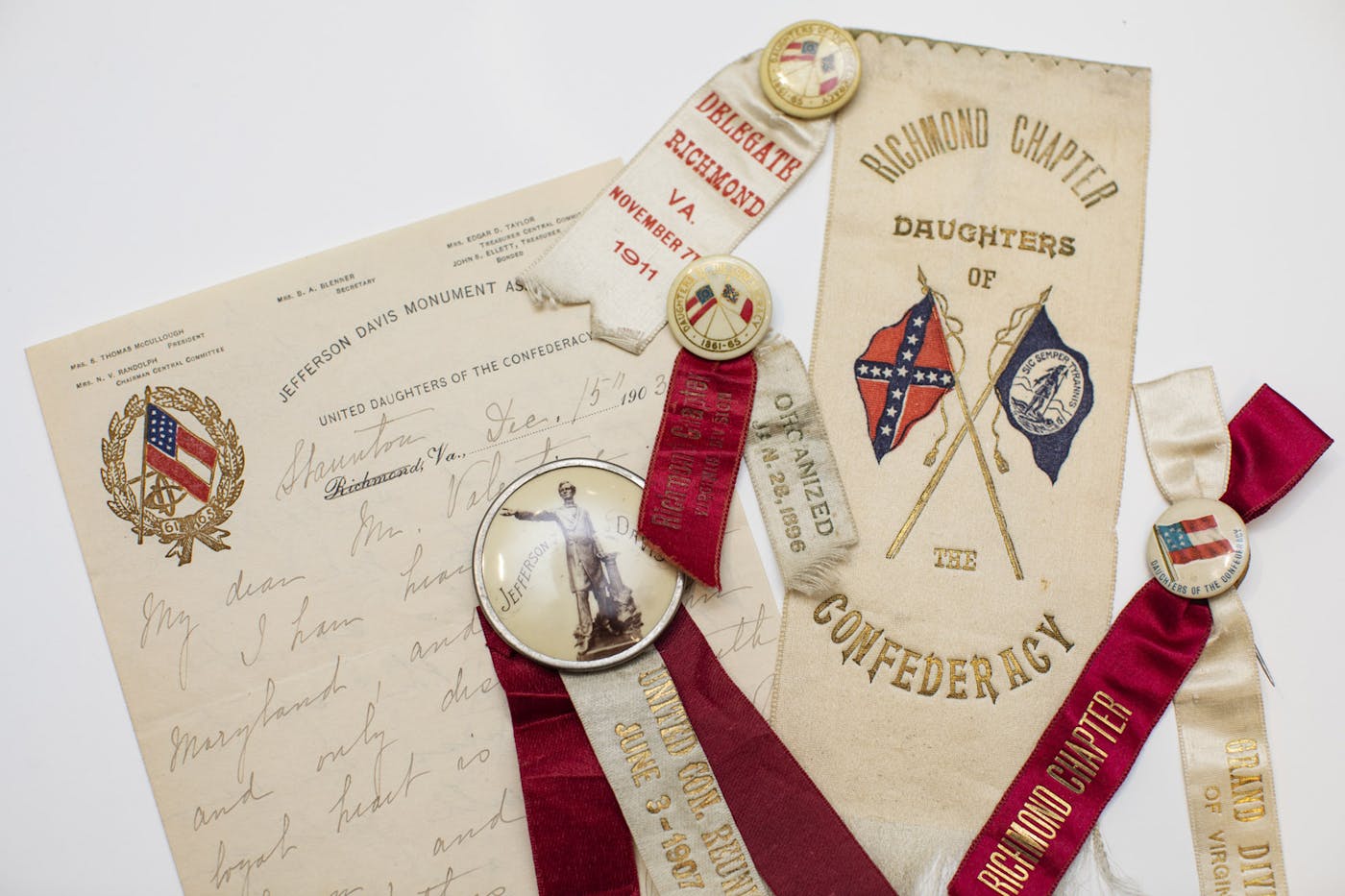
Founded in 1894, the UDC devoted itself to caring for veterans and vindicating the Confederacy, as historian Karen Cox chronicles in Dixie’s Daughters. As offspring of the South’s antebellum patriarchy, the Daughters coped with defeat by refusing to remember their forefathers as anything other than noble and just. Chapters proliferated across the South, and Daughters built statues to be “signposts for the future,” as Cox told me, and advocated for textbooks to teach the Lost Cause. UDC influence subsided after World War I, when membership peaked at 100,000, but America’s race-related conflicts of the twenty-first century demonstrate that the Daughters achieved their ultimate goal. By swaying how children understand the past, they built “living monuments” to the Confederacy. “A lot of the things the UDC did,” Caroline Janney, a Civil War historian at the University of Virginia, told me, “we’re still living with today.”
On a Monday afternoon in November 1957, the Daughters convened in Richmond. According to a 1994 UDC magazine, the day remains the second most important in UDC history, the first being the day the organization formed. At the site of the former R.E. Lee Camp Soldiers’ Home, with a high school orchestra performing and more than 700 in attendance, the Daughters debuted their marble headquarters. Just two months after President Eisenhower signed a Civil Rights Act into law—the first of its kind since Reconstruction—the UDC dedicated its building to the Women of the Confederacy.
The memorial also signifies the comfortable position the UDC once held in the Old Dominion. The Daughters settled in the former Confederate capital after Governor William Tuck, who spent his governorship fighting civil rights laws, offered the land. Virginia’s General Assembly approved the offer in 1950 and tacked on $10,000 toward construction fees. The deed, however, included stipulations: If the UDC doesn’t use the property for five years, it reverts to the Commonwealth. The UDC cannot sell the building, because the state controls the land; the group cannot move it, because it’s marble. If they ever couldn’t pay for upkeep, they would have to abandon the memorial.
Within the walls made of white-veined Georgia marble, the headquarters features libraries, archives, and offices for members’ work. As much as the building is a memorial to wartime women, it’s also a monument to the Daughters themselves. They wrote in the building’s 2008 application to the National Register of Historic Places that it was designed to “resemble a mausoleum,” a fitting choice for an organization preoccupied with the dead. The application also includes a more ominous detail: The Daughters iterated that the building should be fireproofed.
The decades brought civil rights to Richmond, and the marble continued to shimmer in the sun. Then in 2015, the white walls were graffitied; four years later, the street was renamed for hometown hero Arthur Ashe. The Memorial to the Women of the Confederacy is now on a boulevard that honors the first Black man to win Wimbledon. But it wasn’t until 2020 that the UDC arrived at its third most important date: In the early hours of May 31, Molotov cocktails sailed through its windows. Outrage over the murder of George Floyd had reached Richmond, and the reckonings were aimed at symbols of Confederate glory. By morning, the UDC’s library was smoldering. In messages that circulated on Facebook, the president general wrote that the office manager watched the attack remotely through security cameras. If she hadn’t called 911, the blaze could have consumed the building. Another Daughter chronicled arriving to the aftermath in a 2023 UDC magazine. She detailed that the fire chief salvaged artifacts as the women waited outside. “I asked him if the 31st Virginia Flag had survived,” she wrote, referring to (as UDC documents suggest) Stonewall Jackson’s flag. “He came back out and shook his head.” The charred, graffitied building would be saved, but the night proved the memorial was not, in fact, fireproof.
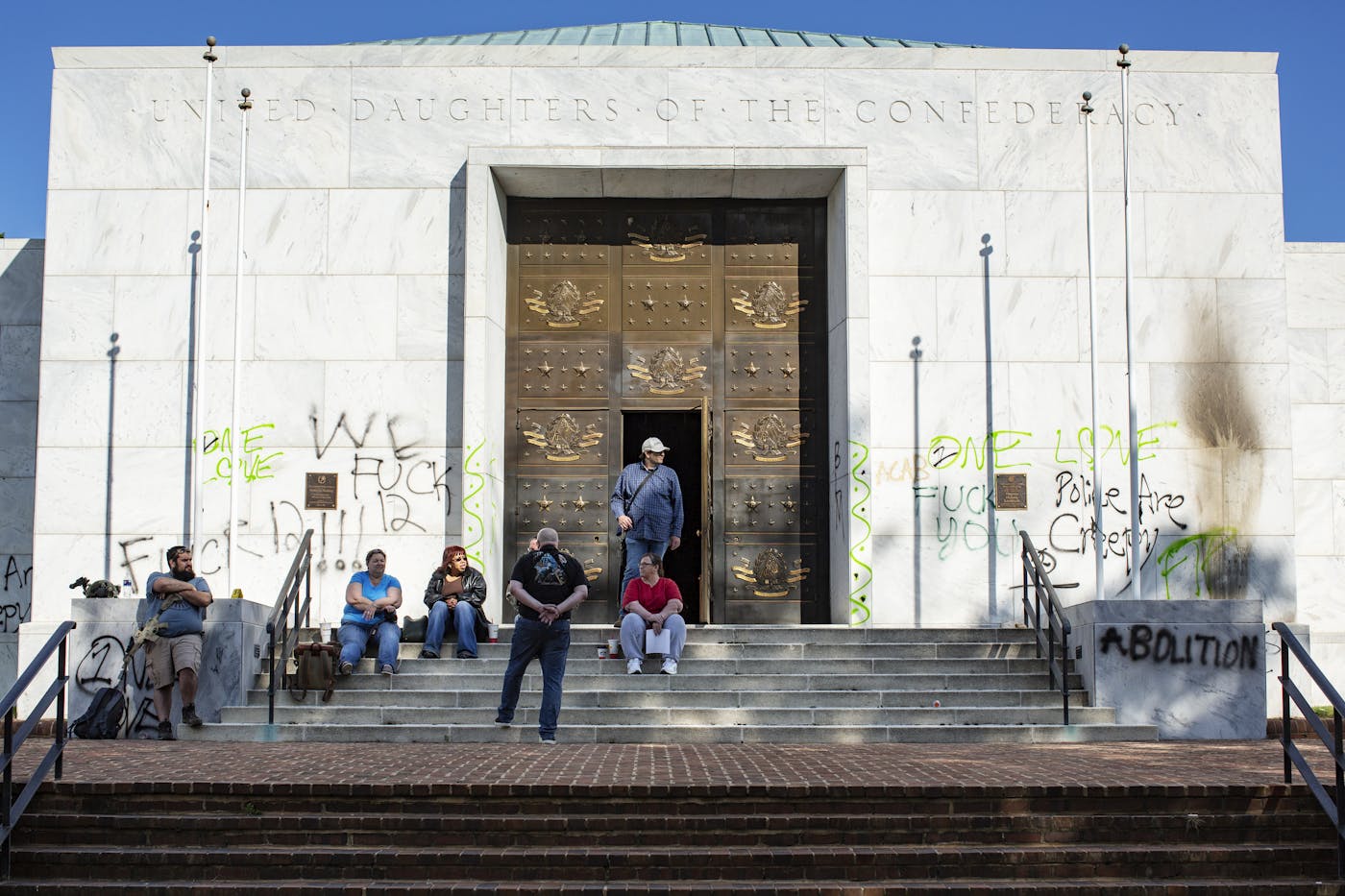
In the succeeding weeks, Mayor Levar Stoney, the youngest person ever to hold the title in Richmond, ordered the removal of all Confederate statues from city property. When the last statue, of General A.P. Hill, was lowered in December 2022, Stoney said it marked “the last stand for the Lost Cause in our city.”
When I visited Richmond, I met with Stoney and asked about the statement, considering the UDC’s presence in town. As a nonprofit, it’s free to exist, he said. “But this is a divorce between the city of Richmond and the Lost Cause,” he added, “and when you have a divorce, the other person is still able to live their life, but you are making the claim that this is the end.”
Stoney isn’t the only official looking to sever ties with the Lost Cause. In 2022, General Assembly Minority Leader Don Scott, a Democrat, learned that alongside churches and hospitals, the UDC’s Virginia Division and General Organization receive a special tax exemption on real estate. He told me he was “disgusted” that the government would subsidize a “historically racist organization,” even if the organization no longer sells or purchases much real estate. In January, he proposed a bill to remove the exemption, which failed, he said, after Speaker of the House of Delegates Todd Gilbert, a Republican, “pocketed” the bill so it wasn’t brought to a vote. Gilbert didn’t respond to requests for comment; perhaps the UDC still has some allies in power. Regardless, Scott said he’d reintroduce the bill. “The fact that they still exist is tough to deal with,” he told me. “If you go to Germany, there’s no ‘Daughters of the Nazis.’”
When I attended the 2021 convention in Myrtle Beach, I learned that comparisons like Scott’s, which are made routinely (but usually to the KKK) strike a nerve. Amid the convention’s pin sales and auction—stocked with a “Make Dixie Great Again” hat and Gone With the Wind curios—the Daughters traded anecdotes of being accused of racism for their affiliation with the group. “But I will tell you,” the historian general said during a workshop. “I don’t have a racist bone in my body.”
Rather than examine why comparisons like Scott’s are made, the Daughters seem convinced that anyone who doesn’t like them just doesn’t know who they are. Current president general Jinny Widowski wrote in a January UDC magazine that the media “is certainly not respectful or fair” and is to blame for widespread misunderstanding of the organization and, by proxy, for the attack on the building. I emailed Widowski, inviting her to speak for this article. I told her I wanted to be fair. She never replied.
“Just the nicest ladies” is how the Daughters see themselves. They often used such phrases while discussing their charity projects. Divisions annually report how many hours of volunteer work they complete: in 2021, over 12,000 hours in Florida, over 180,000 in Texas. But their use of the phrase also suggests how they define “racist”: someone who feels animosity toward Black people, who wishes to see communities of color suffer. And “white supremacy” is associated with violence, not societal conditions. By holding to these definitions, the Daughters maintain confusion as to why such terms are applied to them. They don’t feel these things; they’re just nice ladies.
I spoke with a former member of the UDC’s brother group, the Sons of Confederate Veterans (he requested anonymity), who cautioned me against generalizing the organization, which isn’t a monolith. He worked with Daughters in Richmond for years and said some divisions are more genteel, others more “hard-core.” Some Daughters want to save statues—especially in North Carolina—others just like to hang out with friends. And some were formerly members of the Children of the Confederacy, the auxiliary organization where youth learn “true” history. In 2021, the youngest member was added at only 45 minutes old, so I found it ironic—and disturbing—when one Daughter told me she sympathized when descendants of the enslaved are offended by Confederate statues. But she added that it’s important to make sure such people understand the true narrative: “You can tell them that they have been lied to all their life.”
One ubiquitous trait across the organization, as membership requires, is Confederate ancestry. When I chatted with women, my eyes drifted to the red ribbons fastened to their chests. They were plastered with tiny brooches, or insignia pins. Daughters collect pins to commemorate how many decades they’ve been members or to honor their heroes like Stonewall Jackson and the UDC founders. This sartorial hallmark also serves a purpose: It venerates the ancestors. Thin gold bars, like little tombstones, are engraved with the names of their forefathers. Daughters often trace their lineages to many Confederates, commemorating each with a bar, their ribbons functioning like little cemeteries.
During a formal evening when the women dressed in shimmering gowns, I was asked to stand before the convention. They wanted to applaud me for being a “prospective member.” Rising from my seat in a thrifted frock, I was struck by more than mortification: I was struck by how badly the UDC wants new members. I saw a surprising number of Gen Xers in Myrtle Beach, but the Daughters, as is widely assumed, are mostly older. The organization, which reported 564 chapters in 32 states and D.C. in the 2021 minutes book, is therefore shrinking. During one business session, the president general at the time acknowledged that many women quit “when the George Floyd happened.” Her own chapter in Alabama lost 29 members. “From what I’ve heard ever since I joined the UDC,” she said to the convention, “is that when we get under 14,000 is when we’re gonna really have a problem.” At the time, the organization reported 14,241 members. Though some chapters reported adding new Daughters, I wonder, two years later, if the organization has now crossed that defining threshold.
As I hung around Richmond waiting for the Daughters to return my call about touring the building, I visited other institutions complicit in propagating the Lost Cause. They were happy to speak.
In a brick row house down the street from the White House of the Confederacy, a statue of the former president is spotlighted—lying on its back. After Jefferson Davis was pulled to the ground in 2020, the Valentine, a museum that presents Richmond’s history, was delighted to welcome him home. “A rope was tied around his waist and attached to a sedan,” Christina Vida, the curator of general collections, told me with a grin, “and he was pulled off his pedestal.” Vida has neat brown hair that swished at her shoulders as she circled the fallen Confederate on temporary display in the gallery. She pointed to his broken arm, flattened face, and coat of Pepto-Bismol pink paint. She said that of all Confederates doused in 2020, this remarkable pink was found only on Davis. She quite liked it.
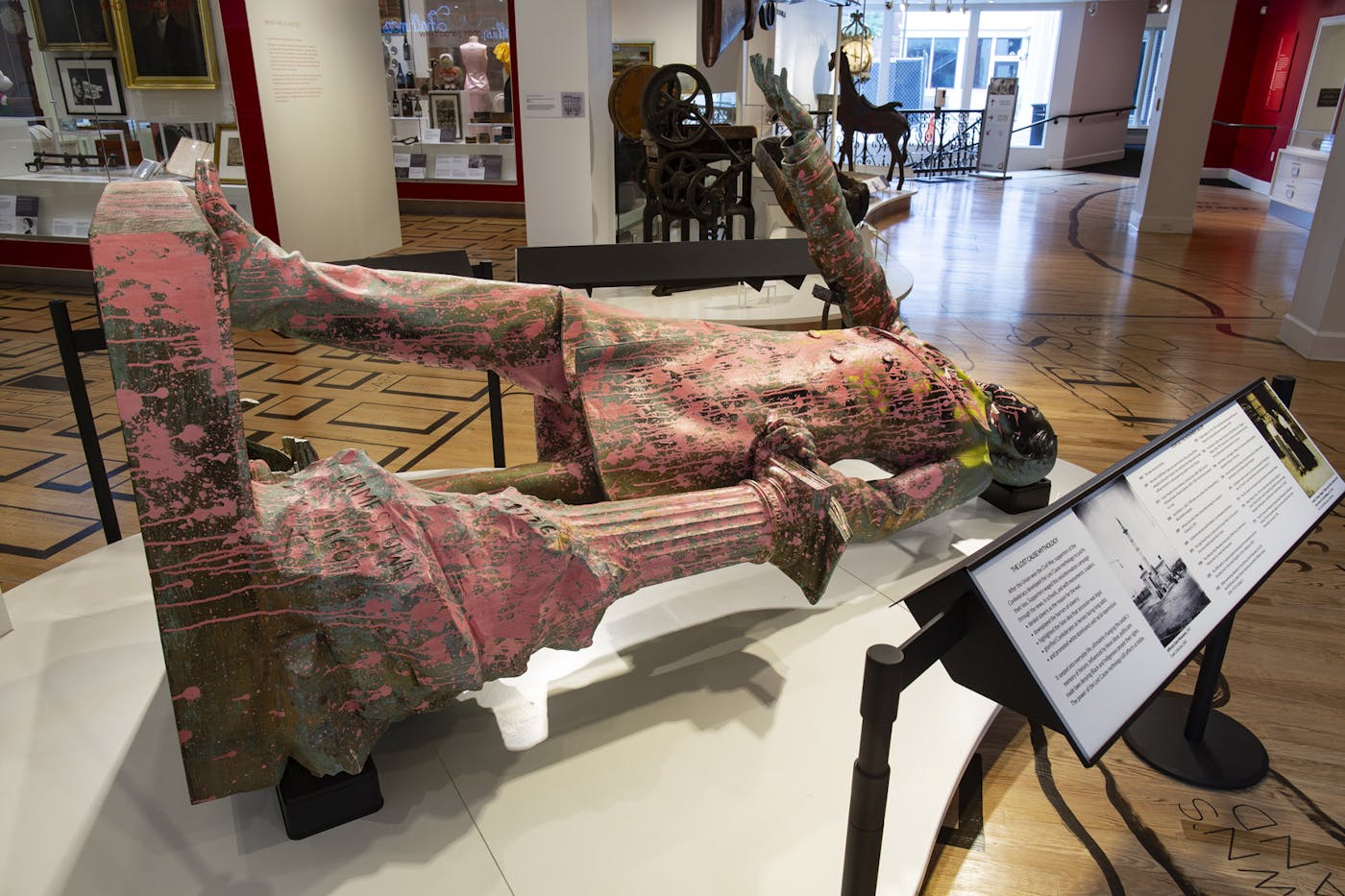
The Valentine traces its roots to Edward Valentine, a member of an aristocratic family in antebellum Richmond. Valentine spent the war studying art in Europe, and was depicting Confederates before the final shots were even fired. He was “helping to define the visual imagery of the Lost Cause,” Vida told me, by fashioning generals as godlike. Rather than historical renderings, the imagery of Richmond’s Confederates could be better likened to propaganda. Valentine sculpted Davis, and the statue, funded by the UDC, debuted in 1907.
For years, the Valentine had been trying to bring Davis off Monument Avenue. The opportunity came in 2017, when Stoney established the Monument Avenue Commission, a collection of historians, museum professionals, and City Council members tasked with considering the future of Richmond’s Confederates. The commission found that even where Richmonders disagreed on how to change Monument Avenue, a majority agreed change was needed. Most decisively, the commission recommended Davis be removed. “Of all the statues, this one is most unabashedly Lost Cause in its design and sentiment,” the commissioners wrote in their final report. Besides, Davis wasn’t even from Virginia.
Stoney told me regulations protecting war memorials complicated implementing the recommendations, and he reallocated funds for next steps when the pandemic hit. But after George Floyd’s murder, especially once a rope affixed Davis to an accelerating sedan, the recommendations were no longer applicable.
There’s a lacquer on Davis’s wounds—a smashed nose, a chipped thumb—to preserve the damage. Tufts of a tissue noose still stick to his neck. When I asked Vida what she thought about the fact that he returned like this, she told me she’s thrilled. In this condition, he doesn’t need placards contextualizing the Lost Cause: He’s a new monument altogether. Atop a pedestal, Davis’s outstretched arm once commanded authority. From the ground, he’s reaching for a helping hand that no one seems to be offering.
Church Hill is gentrifying, folks around Richmond told me. The neighborhood is up the road from Shockoe Bottom, where an African burial ground and jail used to be, on the James River. It was in a café on the hill that I met Julian Hayter, a history professor at the University of Richmond. He had tattoos on his arm for places he’s lived: Seattle and Los Angeles. But his predecessors came from Virginia. “Most African Americans are from the South, right?” he said, sipping a Topo Chico. He was referring to the fact that most African Americans can trace their ancestry to those who were enslaved. The largest slave port on the East Coast was down the hill in Shockoe.
Hayter served on the Monument Avenue Commission, and when I asked about the commission’s only public forum, which 500 people attended, his eyes narrowed: “Oh, it was a fucking disaster.” The opportunity for discourse devolved into a shouting match. During the gathering, Hayter noticed the UDC’s past efforts at work: Boomers parroted Lost Cause textbooks. I knew firsthand what these textbooks were like. While antiquing in Alabama last summer, I found a tattered green textbook: Know Alabama. The book—dated 1961 with revisions in 1965, and assigned to students through at least 1973—teaches students that slavery was one of the “happiest way[s] of life in the South.” It includes illustrations and immersive dialogue with “Mammy,” who gladly cooks “you” breakfast. AL.com, which won a Pulitzer in 2023 for its commentary on Alabama’s whitewashed history, reported in 2022 that the UDC vetted the textbook. When I brought it home, my mom recognized it from her fourth-grade history class.
“The UDC was actually pretty smart,” Hayter said. Not only did the group commit the sin of commission through its statues and textbooks, he explained; it was also “motivated by the sin of omission: just simply not talking about certain facets of history.”
I later drove down to Shockoe and saw the parking lots and overpass that cut through sites where Africans were auctioned and buried. I also toured Jackson Ward, a historically Black neighborhood that once earned the monikers “Black Wall Street” and “Harlem of the South.” In the 1950s, the city split and devastated the neighborhood with a freeway. Six lanes of interstate now run where Black families lived and worked.
Looking at Richmond’s landscape, you wouldn’t know it hosted the East Coast’s biggest slave port, or that the newly emancipated swiftly established a vibrant community. Instead, you saw Confederate power.
But the landscape is still changing: Independent efforts to memorialize this overlooked history are getting a boost. In 2022, the Mellon Foundation granted the JXN Project, a nonprofit devoted to historic preservation in Jackson Ward, $1.5 million; the foundation also granted Richmond $11 million to build a cultural learning center about the slave trade in Shockoe.
“But that’s heritage,” Hayter told me at the café. “It’s looking away from a particular history and venerating another at the expense of historical truth.”
“Well, that’s the irony of ‘Dixie,’” I replied, thinking of the consequences of practicing the song. “The lyrics tell you to look away.”
Outside the memorial to Confederate women, a bronze horse is mid-stride. The horseman turns in the saddle to gaze over the treetops. He’s wearing a hoodie, and Nikes grip the stirrups. The rider is a young Black man.
The statue, Rumors of War, was unveiled at the Virginia Museum of Fine Arts in 2019. Michael Taylor, the chief curator at the VMFA, told me Kehinde Wiley, an artist best known for his portrait of Barack Obama, proposed the design after seeing Monument Avenue. Wiley’s rider strikes the same pose as the statue of General J.E.B. Stuart, infamous for leading Confederates to ruin at Gettysburg. Taylor acknowledged that once Stuart came down in 2020, some complained that Rumors became redundant. He disagrees. Either way, I noticed the horse is charging the UDC’s headquarters.

Since they dodged my requests for a tour, I was surprised when the Daughters fulfilled my order for UDC magazines. A secretary told me she would leave them with a guard.
Whenever I passed the building, I noticed a man sitting by a side door in a folding chair. After the 2020 fire, the UDC began funding round-the-clock security. Even though the expense has drained their coffers, members see a silver lining. “The good thing about this company is that they’re all African American,” the 2021 president general said during a business session in Myrtle Beach. “And these men love us,” she said, adding: “We couldn’t have paid for the P.R. these fellas have done for us.”
Through the paradox of her statements (that the men are, in fact, paid), I noted a refrain of the Lost Cause: that perceived loyalty of Black Americans proves Confederates weren’t white supremacist—even if the nation was founded on, as Vice President Alexander Stephens declared in his 1861 “Cornerstone Speech,” “the great truth that the negro is not equal to the white man.”
I wondered how beneficial the guards were for “public relations,” considering the building’s Google reviews. A slew of recent single-star posts by alleged VMFA visitors complained of confrontations. “Add a fence if your security guards are to scream at anyone who even glances in the building’s direction,” one read. A VMFA security worker told me he regularly witnessed such interactions, adding, “There are only ever Black men who work that job.” He elaborated with an uncanny choice of language: “It’s part of creating, I don’t know, some kind of public-relations image.”
When I approached the building, the guard was nice. He wore a casual, black uniform with what looked like a gun on his hip. After handing off my magazines, he was willing to chat. He wasn’t from Virginia. He came down from New York for the job. And I was surprised at how quick he was to agree: He’s happy to be P.R. “When I tell people the name of the building, they think, Oh, racists,” he said. “But it’s not like that now.” I asked if he believed that, as a Black man, his presence helped the group’s image. “Exactly,” he replied, adding that it’s not something people expect. “But there’s a Black woman that works in there,” he continued, gesturing to the door. “So they should take a look at that.”
It feels unfair to single out the Black woman in the building, so I haven’t used her real name. But as the guard suggested, this Daughter deserves a closer look. As a researcher, Lisa is one of few UDC employees, but one of multiple Black members—allegedly. While Daughters often mention that not all members are white, they claim they can’t actually provide numbers because the application doesn’t ask for a woman’s race. In Myrtle Beach, Lisa was the only Black Daughter I saw. But, like the guard, members regularly point to her as evidence that the organization isn’t racist.
I chatted with Lisa in Myrtle Beach, and she told me, with a laugh, “Antifa posted on Facebook that I have Stockholm syndrome.” When I emailed her about speaking for this article, she declined. I asked again when I called the building. She was nice, but she declined.
When I parked outside St. Paul’s Episcopal Church, I realized just how short Jefferson Davis’s walk was from the Confederate White House. He was in the sanctuary when he received word on April 2, 1865, that the Confederates were vacating their capital. St. Paul’s survived the fire they set to the city while retreating, but as Richmond reconstructed—both its buildings and its understanding of the war—the church got a fresh coat of Lost Cause paint, too.
Anne Hayes, a member at St. Paul’s, met me in the church lobby and led me to an upstairs closet. Tables lined the walls, laden with Confederate imagery: altar cushions embroidered with flags, brass pew markers designating where Lee and Davis sat, and plaques exalting the Confederate first family. These icons were displayed in the sanctuary throughout the past century.
“I keep finding things like Confederate flags around the church,” Hayes said, pointing to a flagpole. She found one particular flag after climbing over a stack of chairs in an acolyte closet. “It was purchased the same day the Southern Manifesto was issued.” The purchase indicated St. Paul’s support of the manifesto, a document published by segregationist congressmen in 1956 to protest Brown v. Board of Education. My ears pricked up when she added that the church’s first Confederate flag was a gift from the UDC. I hadn’t expected to learn about the Daughters at St. Paul’s. The organization also helped install the Confederate icons in the sanctuary, Hayes told me. “Hang on,” she muttered, as she pulled open the drawer of a filing cabinet.
After the 2015 white supremacist massacre of nine Black parishioners in Charleston, St. Paul’s felt compelled to respond. The church established the History and Reconciliation Initiative, an effort to catalog, research, and contemplate its complicity in perpetuating Lost Cause myths. A display board about the initiative was among the plaques in the closet. Across the top, it read: “What Happens When You Look Again?” Or: What happens when you no longer look away?
St. Paul’s decided to begin removing Confederate imagery in 2015. Though some parishioners weren’t happy with the decision, the church ultimately found that more people began visiting and attending. But before the last icon came down, new memorials went up. Amid the demonstrations of 2020, the clergy discovered “George Floyd”and “I Can’t Breathe” spray-painted on the steps. Church leaders decided to remove the remaining Confederate icons, but to leave the paint. In a statement, the rector explained: “Considering the years-long conversations St. Paul’s has had about memorial plaques, how could I not see these names as memorials?” The church decided that meditating on these images, rather than Confederates, better aligned with its mission.
Hayes emerged from the filing cabinet with a manila folder. UDC was penciled on the tab. The contents documented the church’s relationship with the organization. There were yellowing records: a 1930 register noting that St. Paul’s hosted the UDC for Lee’s birthday; a 1970 bulletin welcoming the Daughters sitting in Davis’s pew. But among them, I saw printed emails dated this century. In 2006, a clergyman told a UDC representative that it was an honor hosting the group. Since St. Paul’s is nicknamed “The Cathedral of the Confederacy,” he wrote, “it is particularly appropriate that you should have your memorial service here.” Hayes noted that the clergyman welcomed everyone, but added that the UDC’s routine memorial services soon came to an end.
“I’m a Southerner—you can hear from my accent,” the Reverend Wallace Adams-Riley said when we later spoke on the phone. Adams-Riley became rector at St. Paul’s in 2008. He’s now the senior chaplain at a prep school in South Carolina. He descends from 11 Confederate soldiers. “It wasn’t as though I’m just some person coming in from the wild blue yonder with no investment in these questions and tensions,” he told me.
Adams-Riley said he felt uneasy about hosting the UDC’s services when he joined St. Paul’s. He recognized that some people may only associate the Daughters with honoring ancestors, but the group reminds others of historic racism. “One option would have been to just lop it off,” he told me, and tell the Daughters they were no longer welcome. But when they reached out in 2014, Adams-Riley took a different approach. He replied that St. Paul’s would host their service under one condition: UDC leaders needed to meet with parishioners and clergy for a dialogue. They wanted to discuss mission and values. No matter what came of the conversation, St. Paul’s would host them at least once more. “We didn’t know what they were gonna say,” he told me. “We were very happy to have them agree readily.” The Daughters confirmed they would be in touch to schedule the meeting.
Then weeks passed, and “more weeks went by.” Then the facilities manager approached Adams-Riley about a curious situation. The UDC contacted her about logistics for its service: But wasn’t there supposed to be a dialogue? Adams-Riley realized the Daughters seemed to be trying to dodge the conversation. When he called to remind them of the agreement, “the whole thing just sort of withered away,” and the UDC found another facility. As far as Adams-Riley knows, that was the end of the historic relationship. “In that whole, shall we say, ‘subculture,’ there’s no place like St. Paul’s,” he said. He speculated that losing the relationship was heartbreaking for the UDC. He had anticipated the conversation with hope; St. Paul’s was genuine in its desire for dialogue. He was disappointed. It all sounded familiar.
“And when I say ‘pitiful’...,” he paused, trying to interpret how the UDC handled the incident. “There’s this sense of grandness from their perspective about what they’re doing,” he continued, “and that did not feel grand.”
I’m accustomed to the UDC’s rebuffs, but I found it striking that the group refused St. Paul’s, a neighbor rather than a journalist. I asked Caroline Janney, the Civil War historian, why she thinks groups like the UDC resist self-examination, or refuse to engage those who want to take a closer look at who they are. “Maybe it’s self-preservation?” she speculated. “Then you have to admit all those warts.” During our conversation, she pointed me to a scrapbook crafted by a Confederate society in the 1930s. The book pairs newspaper clippings about the Scottsboro trials with updates about the UDC, which at the time was campaigning against a proposed peace memorial that would feature Lee with General Ulysses S. Grant. The Daughters didn’t like Grant. “They talked about how Grant was responsible for ‘letting loose the hordes of Black people on the South,’” Janney explained. The scrapbook suggested the nine boys in Scottsboro proved the Daughters right. The UDC’s campaign, Janney said, “was absolutely as blatantly white supremacist as you can get.”
Maybe it’s self-preservation. Maybe heritage—ignoring one history to fixate on another—is bliss. Maybe they’re so practiced at confusing Confederate history with the Lost Cause that Daughters can’t see their own history clearly. In their official online statement, their “final word” on the country’s reckoning with the Confederacy, the president general states: “Our members are the ones who, like our statues, have stayed quietly in the background, never engaging in public controversy.” I asked Karen Cox, the UDC expert, about the claim. She agreed it doesn’t add up. “If they understood the history of their organization, some of these things that they say,” she said, “they wouldn’t say.” Janney added that looking away from the full scope of history isn’t exclusive to the UDC: It’s an American problem, one the country still has. When we look away from who we are, we can’t right wrongs. Fixating on what nice ladies we are doesn’t get us anywhere, especially when the fixation is blinding.
When I flip through my UDC magazines, I recognize faces from Myrtle Beach in the glossy photos. The Daughters are smiling, draped in pins engraved with the names of Confederate ancestors. As I skim these pages, a 1965 essay by James Baldwin, “The White Man’s Guilt,” comes to mind. I think he articulated how to understand the UDC best, and most literally, when he wrote: “People who imagine that history flatters them (as it does, indeed, since they wrote it) are impaled on their history like a butterfly on a pin and become incapable of seeing or changing themselves, or the world. This is the place in which it seems to me, most white Americans find themselves. Impaled.”
The day I left Richmond, I walked back by the UDC’s headquarters. A no trespassing sign lay on the grass. Tape appeared stuck to the wire legs poking out of the grass: a repair that did not hold. Because of the property deed stipulations, the Daughters are stuck in their marble behemoth, a building they cannot sell or move and refuse to let go of. I recognized the guard sitting in the shade of a tree, in the shadow of the dreadlocked rider atop a charging horse. A special varnish was applied to the marble after the 2020 attack to make graffiti easier to remove. The windows were fortified, too. The UDC may not speak, but these modifications suggest members do hear rumors of war.
Jefferson Davis and St. Paul’s aren’t the only memorials in Richmond to emerge from the crucible of 2020 refashioned. The monument to the Confederate monument makers likewise better symbolizes who the Daughters now are. From the sidewalk, I see a mausoleum for a dying organization, a fortress for impaled butterflies who refuse to see or change themselves, even as their city changes without them. When I Zoomed with Margaret last summer, when she initially expressed enthusiasm about this article, I asked her about the headquarters. She smiled, and to my surprise, noted that good can come from the bad. After the fire, she said, the building looks better than ever.
*This article has been updated.
